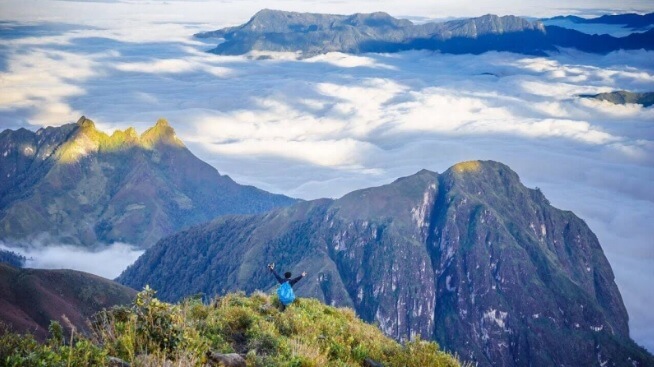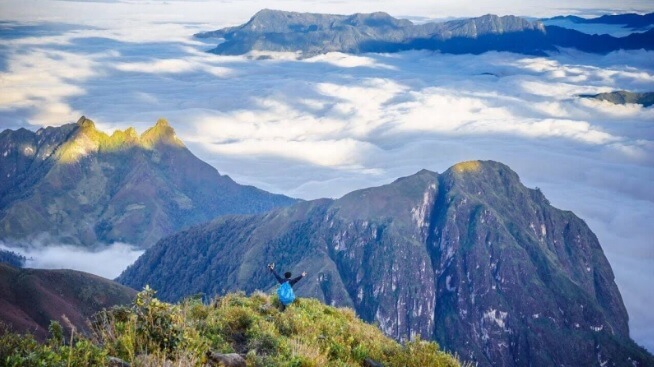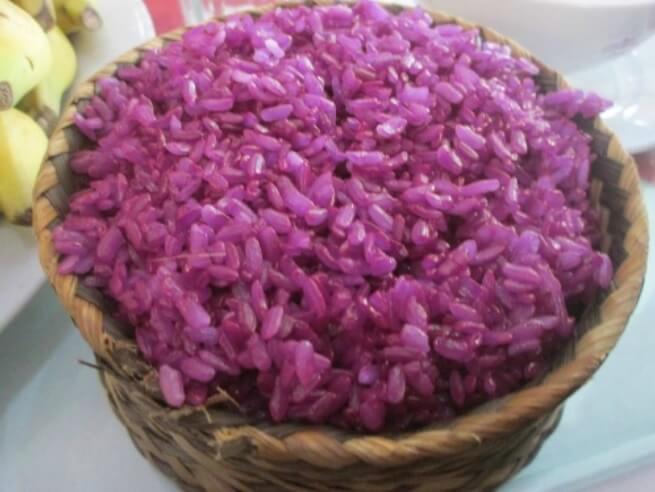Top experience you may interested in:
- Hue to Hoi An motorbike tour via Hai Van pass
- Hue to Hoi An motorbike rental
- Hoi An to Hue motorbike rental
Visit Lai Chau
Visiting Lai Chau means exploring the majestic beauty of the country’s mountains, where over 20 ethnic groups reside, creating a rich cultural diversity. When you travel to Lai Chau, you’ll have the opportunity to discover the famous peaks and passes of our nation. Here, you’ll find yourself surrounded by breathtaking nature, towering mountains, and floating white clouds.
 Visit Lai Chau: 10 Majestic and Beautiful Destinations
Visit Lai Chau: 10 Majestic and Beautiful Destinations
- O Quy Ho Pass: Spanning nearly 50km, with two-thirds located in Tam Duong District, Lai Chau, and one-third in Sa Pa, Lao Cai Province, the O Quy Ho Pass leads to the O Quy Ho Summit, marking the border between Lao Cai and Lai Chau provinces. Winding through the Hoang Lien Mountain range, home to Mount Fansipan – the “Roof of Indochina” at 3,414m above sea level, O Quy Ho Pass is renowned not only for its strategic importance but also for its majestic beauty, ranking among the most spectacular passes in the Northwest.
- Sìn Hồ Plateau: Located approximately 60km from Lai Chau city, Sìn Hồ Plateau sits at an altitude of over 1,500m. Often referred to as the “Second Sa Pa” of the Northwest, Sìn Hồ Plateau experiences four distinct seasons throughout the day, with an average yearly temperature of around 18°C. The cool and pleasant climate of Sìn Hồ Plateau is ideal for growing medicinal plants such as Chinese yam, Astiso, and other temperate vegetables and fruits like plums, peaches, and pears.
- Tân Uyên Tea Hill: Stretching along National Highway 32, the tea plantations in Tân Uyên have been cultivated for 40 to 50 years, covering nearly 2,000 hectares and situated not far from the town center. Tân Uyên Tea Hill captivates visitors with its serene and pristine scenery, making it a popular spot for wedding photoshoots and romantic pictures amidst the lush green tea gardens, basking in the golden sunlight. The tea here, such as San Tuyết, Ô long, and Thanh Tâm, is renowned nationwide.
- Bạch Mộc Lương Tử Peak: Bạch Mộc Lương Tử Peak, situated in Sin Súi Hồ Commune, boasts an elevation of 3,045m above sea level, ranking among the five highest mountains in Vietnam and Southeast Asia’s Lai Chau Province. Conquering Bạch Mộc Lương Tử is a challenging yet rewarding feat for adventure enthusiasts. While not the highest peak, Bạch Mộc Lương Tử is famous for its scenic landscapes and the most fascinating and intriguing exploration routes.
- Pu Si Lung Peak: As the most pristine, mysterious, and captivating mountain in Vietnam, Pu Si Lung Peak lies on the Vietnam-China border in Pa Vệ Sử Commune, Mường Tè District, Lai Chau Province, with an altitude of 3,083m, earning its reputation as the “Roof of the Borderland.” It’s a dream destination for adventurous trekkers seeking exploration.
- Mường Tè Nature Reserve: Mường Tè Nature Reserve spans across Tà Tổng and Mù Cả communes, boasting a remarkably diverse and abundant vegetation and ecosystem, especially the forest ecosystem. The area has been surveyed to contain 542 plant species, including 57 rare species listed in Vietnam’s Red Book and 7 species in the world’s Red Book, most of which are valuable medicinal plants. The reserve also hosts 22 endemic species to the Northwest region, 7 species listed under the Government’s Decree No. 32, and 6 species characteristic of the Northwest: blackberry, chò nước, giổi xương, chò nâu, đinh, sến, lát hoa.
- Pu Ta Leng Peak: Located about 20km northeast of Lai Chau city, Pu Ta Leng Peak stands at an altitude of 3,049m. While Fansipan is known as the “Roof of Indochina,” Pu Ta Leng is often dubbed the second roof, attracting adventurers and young enthusiasts eager for a challenge. From October to March of the following year, when nature is at its best, visitors should consider conquering Pu Ta Leng for its stunning landscapes, particularly the blooming rhododendron flowers from the mountainside to the summit.
- Mường Than Field: Mường Than is one of the four largest fields in the Northwest, located in Mường Than Commune, Than Uyên District. The vast fields not only create a poetic setting amidst the majestic mountains but also produce renowned local products such as non-bao-tử corn, Hoàng Long sweet potatoes, Sén Cù and Tám rice.
- Pu Sam Cap Cave Complex: Situated about 6km from Lai Chau city along Provincial Road 129 connecting Lai Chau city with Sìn Hồ District, the Pu Sam Cap Cave Complex is regarded as the “Number One Cave in the Northwest.” Currently, the complex welcomes tourists to two caves: Thiên Môn Cave and Thiên Đường Cave, showcasing numerous mystical and fantastic stalactites, harboring heart-touching stories of the mountainous people. Pu Sam Cap always presents an alluring invitation to visitors far and wide.
- Sì Thâu Chải Village: Situated about 6km from Tam Đường town, Bản Sì Thâu Chải reveals a picturesque, dreamy scene, a small village of Dao people with more than 60 households. On days with abundant clouds, tourists can immerse themselves in the floating clouds. Bản Sì Thâu Chải presents an unforgettable, enchanting, and captivating sight. Visiting Sì Thâu Chải allows travelers to experience the daily life, production activities, taste the ethnic cuisine, and participate in traditional games.
6 Must-Try Delicacies When visit Lai Chau:
- Cắp nách pork: Cắp nách pork is a specialty of the Northwest highlands. These pigs are free-range in the forest and forage for food, resulting in each pig weighing around 10 – 15 kg. Due to their natural diet of leaves and herbs, the pork is firm and flavorful. Cắp nách pork can be prepared in various delicious dishes such as steamed, grilled, stewed, and soups. Each dish is seasoned and cooked with local herbs, creating unique and delightful flavors that especially captivate first-time visitors.
- Roasted Moss: When visiting Phong Thổ District, do not miss out on the roasted moss – a delicacy of the local Thai people. Moss is readily available in streams and riversides, and the locals meticulously gather them for culinary delights such as soup, grilling, and stir-frying. The moss is cleaned, sun-dried, then roasted on a rock or a wooden board, and smashed a few times before being cooked.
- Pa Pỉnh Tộp Fish: Pa Pỉnh Tộp fish (grilled carp) is an elaborate dish often served on special occasions or when there are esteemed guests. Fresh carp is selected and grilled whole. Before seasoning, the fish is lightly salted with chili powder to remove any fishy smell. The seasoning typically consists of aromatic herbs such as peppercorns, ginger, lemongrass, shallots, forest herbs, and chili powder, which are minced and blended together, evenly spread on the fish’s body and stuffed inside its belly.
- Purple Sticky Rice (Xôi Tím): Purple sticky rice is a traditional dish of the highlands in Lai Chau. The unique purple color comes from a plant called “khẩu cắm,” a type of forest leaf.
- Stone Moss Soup (Canh Rêu Đá): Stone moss is a clean and pure vegetable of the Lai Chau locals. Harvesting moss requires great care, as it is gathered from rocks near streams and rivers. Locals use it to prepare delicious dishes for their families, such as soups, grills, and stir-fries.
- Fern Salad (Nộm Rau Dớn): Fern grows abundantly in the gardens, along ponds, and streams in the homes of the Thai people in Lai Chau. This dish is made by selecting young ferns, rinsing them, sun-drying them to dry, then adding various ingredients such as fragrant herbs, chili, ginger, garlic, MSG, and salt, along with a squeeze of fresh lime.
When planning your next travel adventure, consider exploring the beauty and delicacies of Lai Chau, where nature and culture blend harmoniously, leaving you with unforgettable memories of the Northwest region.
Popular tourist attractions
– Ba Be lake
– What to visit in Mai Chau
– What to Visit in Moc Chau





